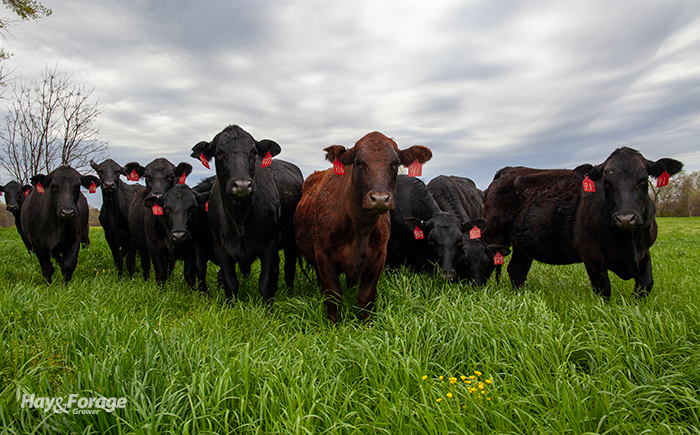Weed out these grazing buzz words |
| By Amber Friedrichsen, Associate Editor |
|
|
 Mob grazing. Management-intensive grazing. Adaptive multi-paddock grazing. The list of ways to describe an integrated system with an emphasis on forage growth and soil health runs on. Comparing the different terms can be confusing. Are they interchangeable? Is one method better than another? Which one is best suited to your situation? Instead of getting caught up in the details, it may be more useful to take a broader look at the principles of soil health that each strategy is rooted in. Matt Poore, an extension ruminant nutrition specialist with North Carolina State University, considers “regenerative grazing” the umbrella term to define management intended to restore agricultural land. The long-term goal of regenerative grazing is to encourage a high level of soil fertility while reducing inputs and boosting the entire ecosystem’s productivity. “Don’t get confused by the terminology,” Poore said. “It all means the same thing: Let the plants rest for a long period of time and graze plants for a short period of time. That is what every one of these systems do.” At Mississippi State University’s Forage and Grazing Management Workshop held earlier this month, Poore noted there are tangible advantages to all versions of regenerative grazing like reduced fuel and fertilizer costs. More holistic benefits include improved health and well-being of livestock, as well as better water quality, nutrient distribution, and soil health. “Those are things that you can really see happening on your farm once you get into this kind of management,” Poore said. Above all, he contended that regenerative grazing fosters better mental health for farmers by eliminating mundane routines and challenging them to be more in tune with their forages, their animals, and their environment. A few key pieces The shift from continuous grazing — or generally less intensive grazing — to regenerative grazing can’t happen overnight as not all current practices should be quit cold turkey. For example, a sudden stop to herbicide use could do a forage stand more harm than good. Aiming to minimizing herbicide applications over time is a more practical goal. With that said, Poore suggested taking an overview of the entire farm, identifying what needs to change, and determining how these changes will affect each other. “Really take a look at your system — understand your forages, your pastures, your soil fertility — and start thinking about how you can improve it, not just one piece at a time, but all of the pieces all at the same time,” he said. Even with an all-encompassing approach, though, there are a few factors to focus on for a successful transition. Electric fence skills are the king pin for regenerative grazing. This is true on both sides of the coin, as farmers must know how to set up temporary paddocks quickly and effectively and cattle must be trained to the polywire. Infrastructure like permanent perimeter fences and watering systems are the next items to reinforce or establish, followed by an outline of a grazing plan that has ample room for trial and error. Most importantly — and likely easier said than done — is the resolve to not give up. Poore noted it can take years before the time and resources invested into a regenerative grazing system start to pay off. Prioritize the principles With fencing skills, strong infrastructure, and a grazing plan in place, producers can apply the principles of soil health in their pastures. These principles include keeping the ground covered, maintaining living roots in the soil, minimizing soil disturbance, introducing livestock to the system, and promoting forage diversity, which may involve embracing weeds. “If we have a well-balanced system, we are going to have some weeds, which are really just a part of a plant community,” Poore explained. “If we have a strong, active plant community, we can have a weed that doesn’t become invasive, and the animals will actually eat it. Then it’s not really a weed in the way that we have traditionally thought about it,” he surmised. Implementing these principles also lays the foundation for a better understanding of key ecological processes, such as the water cycle, the carbon cycle, and nutrient cycles for nitrogen and phosphorus. Poore stated the way these cycles interact and affect soil and plant biology is called community dynamics. When community dynamics are aligned, soil health indicators should take shape over time. The color, the structure, and even the smell of soil can signal greater biological activity underground. Poore said this can be confirmed at the microscopic level; however, higher populations of earth worms and dung beetles denote more biological activity as well. Certain plant species can also communicate positive or negative changes to soil health. On one hand, greater diversity of desirable species is likely the result of healthier soils that can support a more robust system. On the other hand, the appearance of less desirable species could signal one or more soil health principles are not being followed and parts of a pasture are subject to exposed soil, limited nutrients, or compaction. Of course, Poore noted all of these signs must be evaluated within the context of an individual farm. To do this, producers must be willing to enter the gate and evaluate their pastures from the ground level. Doing so may generate more questions than answers, but it is through curiosity and investigation that one will gain more knowledge of regenerative grazing and what it looks like on their operation. “Your farm is very different than your neighbors. You have to take this information and figure out how it’s going to work for you,” Poore asserted. |
